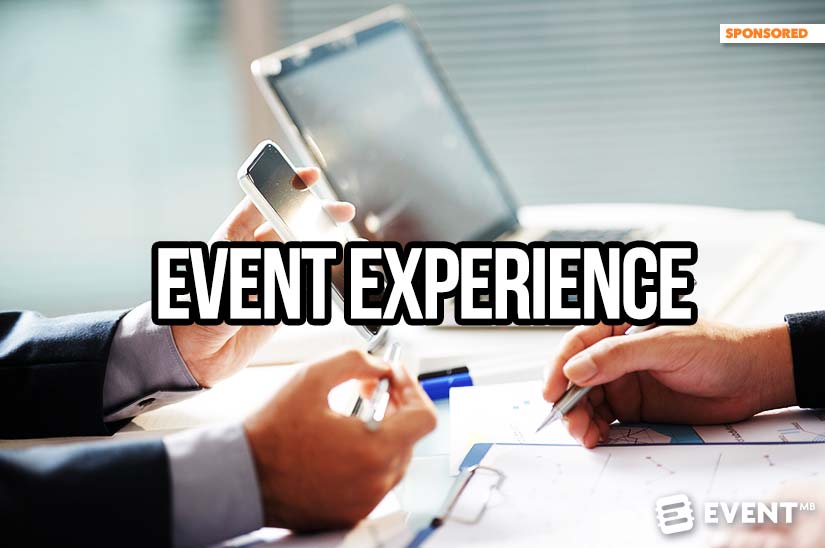This is a sponsored post written by Michelle Wong, Content & Channel Marketing Manager at EventMobi. More information about Event Manager Blog’s sponsored posts.
Event experience design helps us achieve all of this at once. It provides us with the tools to guide our attendees on a rewarding journey that accomplishes their (and our) goals. Event experience design helps create a common vision to guide event design and execution, and carry your desired event narrative throughout the entire attendee journey.
##abovethefold##
What is Event Experience Design?
Event experience design is about intentionally designing an event experience that addresses the motivations of your key attendee personas. It applies throughout the entire event lifecycle, from pre-event to post-event. The concept is a natural extension to our responsibilities as event planners. We are by our very nature the designers of experiences. We’re architects of experience journeys for our attendees. By understanding the character, needs, and desires of our key attendee personas, we gain powerful knowledge that guides our event creation, from beginning to end.
If we don’t design intentionally, we risk leaving the attendee experience to chance. But if we do design intentionally, we increase the opportunity of success for our events. However, replicating cookie-cutter tactics from the past isn’t a wise move, either. Just as attendee expectations are dynamic and constantly evolving, we also need to keep up-to-date on tactics that engage attendees before, during and after our events.
Five Dimensions of the Attendee Experience
A positive attendee experience has to address the attendees’ needs on multiple levels. Before diving into actual tactics, we must understand what our attendees want to gain from the overall event experience, i.e. we have to conceptualize a ‘holistic’ perspective. This approach takes into account their psychological, cognitive, emotional, social and environmental requirements, and the relationship between all of these factors, as described in the popular book Strategic Event Creation.
Psychological: This involves understanding an attendee’s personality, role, status, and image.
Consider This – How do attendees want to be perceived by their peers and colleagues, and how does our event design enable this?
Cognitive: This involves understanding how the psychological aspects influence attendees’ expectations, motivations, and memories of previous events.
Consider This – What are attendees’ previous positive and negative memories and expectations, and how can we build on them to enhance the positive and resolve the negative?
Emotional: This involves understanding how the above factors shape attendees’ emotional needs. For example, happiness, stress, anxiety, euphoria, sadness, fear, etc.
Consider This – How can our event design enhance the positive/desirable emotions and minimize the ones that lead to an unsatisfactory experience?
Social: This involves drawing on all previous factors and understanding how attendees are affected by other attendees and vice versa.
Consider This – What is the relationship attendees have with one another, what relationship do they want, and how does this relate back to the aforementioned psychological, cognitive and emotional factors? How can we enable opportunities for interaction that will help develop or enhance these relationships?
Environmental: This involves understanding the physical space and requirements of the event.
Consider This – How does the space and place affect the other four factors? Can any environmental factors be used to help achieve the desirable psychological, cognitive, emotional and social outcomes?
The Attendee is the North Star of Event Experience Design
Experience Design is all about our attendees. Think of attendees as our customers. Just like any B2C or B2B business, customer service and experience are what’s going to set our events apart from competitors and make them memorable. Also, keep in mind that a happy customer (attendee) is often a returning customer (returning attendee). Ensuring our events are memorable for the right reasons and keeping guests happy will keep them coming back to your next event.
In today’s tech-laden society, we can’t have a one-size-fits-all mentality, where each attendee has the same experience. Attendees are smart and becoming more demanding and particular in having their needs met as quickly and easily as possible. Why go to an event where the registration process is painstakingly slow or booking a hotel makes them want to pull their hair out, when another competing event takes advantage of event technology that creates a seamless and personalized pre-attendee experience? This is why event experience design focuses on understanding attendees’ interests and preferences, and uses that information to create personalized communications and and interactions.
Personalized experiences are a hot topic these days. Certain types of businesses have become very skilled at delivering personalized service, such as those within the retail and hospitality sectors. And considering that as event planners we work within the hospitality sector, providing personalized experiences should be a top priority for us in order to stay competitive and exceed attendee expectations.
The Attendee Journey is the Roadmap to Experience Design
It’s often the simplest things that build lasting customer relationships in the long run, but how do we identify those opportunities? And how do we know which opportunities will have the biggest impact? This is where experience mapping, also referred to as attendee journey mapping, becomes an essential tool in our event planning toolkit.
The attendee experience doesn’t start when our attendees enter our event. Nor does it end when an attendee leaves the event. The attendee experience may actually start weeks – maybe even months – earlier, or if they are a returning attendee, their experience may even be a continuation from the previous event.
The attendee experience starts as soon as our attendees learn about our event, or decide to participate. It continues when they board the plane, rent a car at the airport, and check into the hotel. It comes to life as they walk into the lobby, review our materials, and begin to interact with other attendees and speakers.
And the event experience lasts far beyond those onsite touchpoints. It’s not over until our audience stops engaging, stops taking action or until the goal you have motivated them to accomplish has been achieved. This could (and in many cases, should) be an experience that spans months or even years!
As event planners, it is vital that we understand this entire, comprehensive journey, because every touchpoint along that journey is an opportunity for us to make a difference. It’s also important that we leave nothing to chance, including allowing time for attendees play, wonder, or interact with content and others at their own leisure.
We need to look above and beyond the event itself to consider the entire journey, and deliberately design compelling experiences that consider all the dimensions to an attendee experience.
Mapping the Attendee Journey
There’s been a lot of talk in recent years about companies mapping their “customer journey”, i.e. the key touchpoints where a customer interacts with a company. Mapping the customer journey provides insights into figuring out what’s working during the buying cycle, and where the gaps lie between what a customer wants and what the company is providing.
If we consider ourselves as experience designers, it makes sense that we take advantage of this tool and apply it to our events. An attendee journey map can be used in the same way that customer journey maps are used by Fortune 500 companies. The end goal is essentially the same – trying to provide our audiences with the best experience possible so they keep coming back for more and recommend the experience to others.
In the context of events, we can consider a touchpoint as any point of interaction between our organization/staff and other attendees throughout the journey. This includes hearing about the event to filling out the satisfaction survey, and everything in between.
A few important touchpoints to consider are any promotional activities taking place, the event website, registration, hotel facilities, on-site and digital signage, networking, sessions/presentations, WiFi, food & beverage, and entertainment. The list can be as extensive or as short as necessary because it’s tailored to each event, so every journey will look different.
What’s important to consider is that when identifying the touchpoints, it’s a good idea to consult with actual attendees. Otherwise, we risk identifying or emphasizing points of lesser importance and as a result, our attendee journey map will not correspond to the real attendee experience.
Attendee Journey Mapping in the Digital Age
Event technology can play a crucial role in the attendee mapping process. Mapping the attendee journey was a consistent theme at Transform USA 2017, one of the leading conferences that focuses on analytics and digital strategy for the events industry. Sessions focused on the relationship between digital technologies and the attendee journey, technologies to use at each touchpoint, data that event organizers can and should collect, and tools for analyzing the data.
The events industry is definitely aware that the digitization of event processes and attendee experiences is becoming a necessity for sustainability and growth. But, with so many viable technology options available to us, and messages being thrown at us from all angles, if can be easy to get lost in the chaos. That’s why it’s so important to remember that using the attendee as our North Star will guide us in the right direction to ultimately designing a winning attendee experience. We can’t let ourselves get distracted by all the other shiny lights. There might be 10 different technology options that can be used during an event, but which ones will actually enhance the attendee experience and create a seamless process for our audience?
Five Best Practices for Using Event Technology to Create a Memorable Experience Design
Event technology is a powerful way to enhance all the touchpoints throughout the attendee journey – everything from the moment of creating awareness through acquiring attendees, engaging them, looking at the results, and building long-term relationships.
According to a CEIR 2016 study, attendees bring an average of 1.5 mobile devices (smartphones and tablets) to an event, along with laptops. Forrester also predicts that 2018 will be the year that mobile becomes core to the digital ecosystem. Devices are evolving to seamlessly work together, which will ultimately influence the demands that consumers (attendees) place on their expected experiences. With this in mind, it’s critical to ensure that our event content is maximized for every and any type of device.
Luckily, there are many mobile event technologies for us to consider. Let’s take a look at how event technology can be incorporated into the design of our events to create an easy, memorable, and valuable experience for our attendees during important touchpoints.
1. Creating an Easy Registration & Ticket Purchasing Process
Registration is one of the first impressions we make on a potential attendee and there is nothing more frustrating than a difficult online registration or ticket purchasing experience. Streamlining the registration process starts the attendee journey off on a positive note, and makes it easier for us to build on it as the event experience continues. Quick registration and ticket sale technology will help ease any frustrations attendees may have experienced in the past.
2. Gathering Data to Understand What Our Attendees Want
When planning, and during an event, it’s important to consider what attendees want and expect in order to provide the content and overall experience that most appeals to their needs. When our events fail to meet attendees’ expectations, they generally never come back. In order to maximize return attendance, we need to ask our attendees what they want, and then make sure to deliver it.
One of the best ways to discover what event attendees want is to ask them in a pre-event survey. Using pre-event surveys to ask attendees what they want before they get to our event will ensure we can tailor event content and activities according to their interests and provide value to them. Sending out surveys is simple to do with push notifications through an event app, or via an email.
They key to gathering survey feedback is to make sure that you’re asking the right questions in the right way. Here are best practices on how to structure your survey and avoid sending out the worst event survey ever!
3. Promoting Attendee Networking Through Gamification Activities
Most of us have probably heard of event gamification, and maybe even participated in games at a recent event. The idea of applying gaming mechanics — like points, badges, and leaderboards — has been growing in popularity with the rise of smartphone usage. Think of it as a tactic to guide attendee behavior in a way that will improve their event experience. For example, many people attend events to network and meet new people; gamification activities can help break the ice in a fun and engaging way.
Making use of an event app is an easy way to implement gamification at events. Attendees can be rewarded for interacting with others, visiting exhibitors, or attending sessions. A posted leaderboard will also help fuel friendly competition and a fun experience. There are many creative ways to execute gamification activities.
Here’s an example of what a gamification feature could look like on an event app:
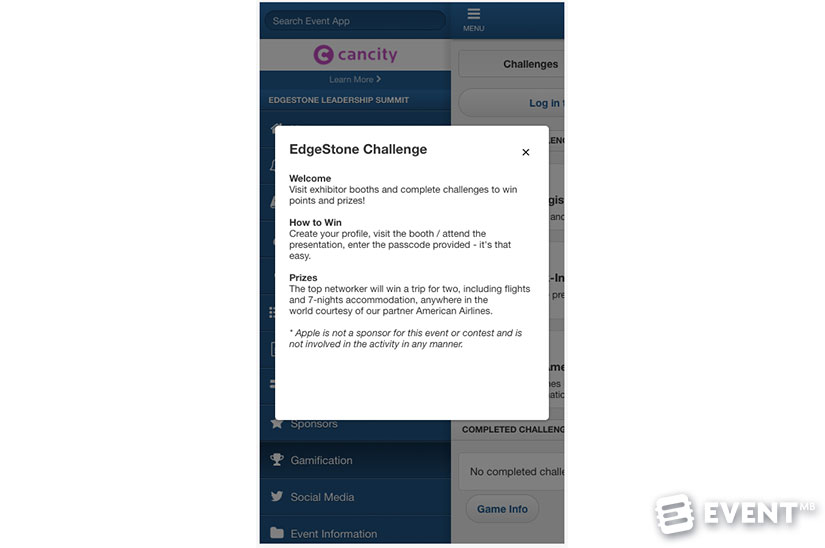

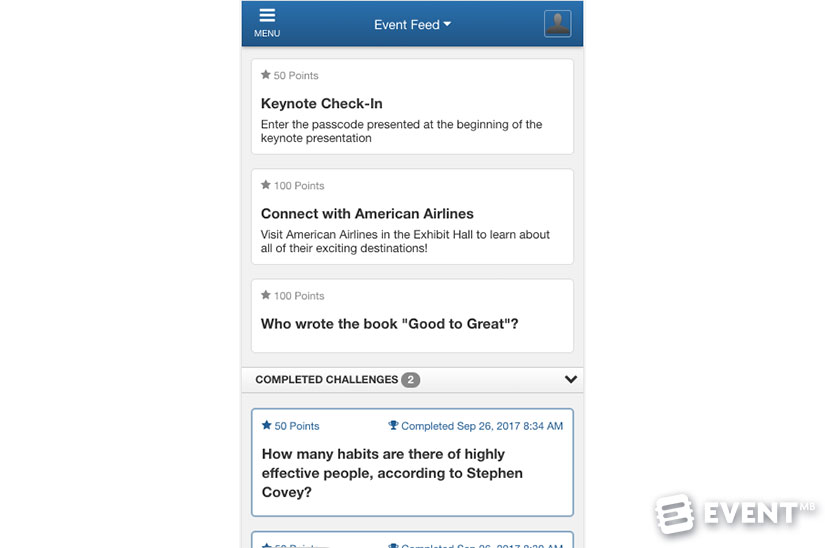

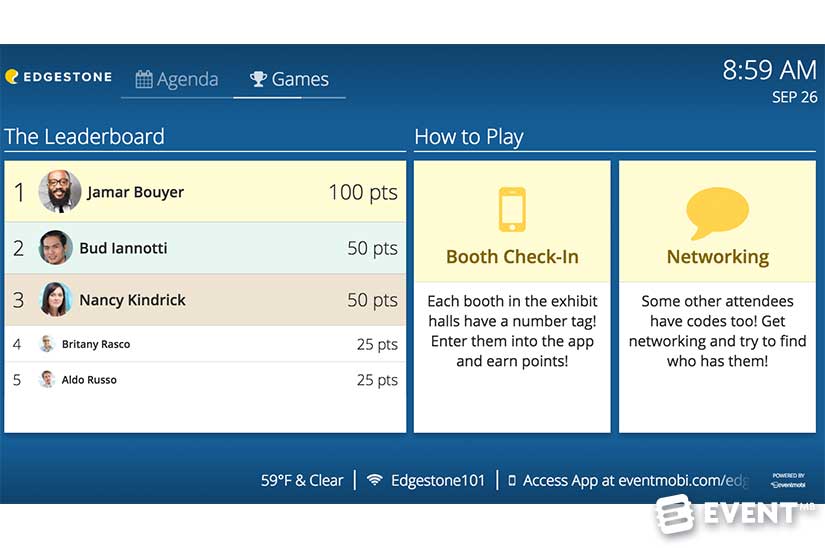

4. Using Live Display for Real-time Communications
The first step to keeping attendees engaged is to keep them informed. No one likes being left in the dark, alone and confused. Digital signage technology allows for an engaging and dynamic way to display key information on screens throughout your event. Plus, it can be easily managed onsite and updated in real-time.
This type of technology allows us to communicate critical event information, such as up-to-the-minute announcements or schedule changes. The event agenda and session information can also be featured on digital signage so that attendees know what’s happening now and what’s coming up next. Even social media and the gamification leaderboard can be featured, to keep attendees motivated to keep playing and interacting with each other.
Here’s an example of what digital signage for an event could look like:
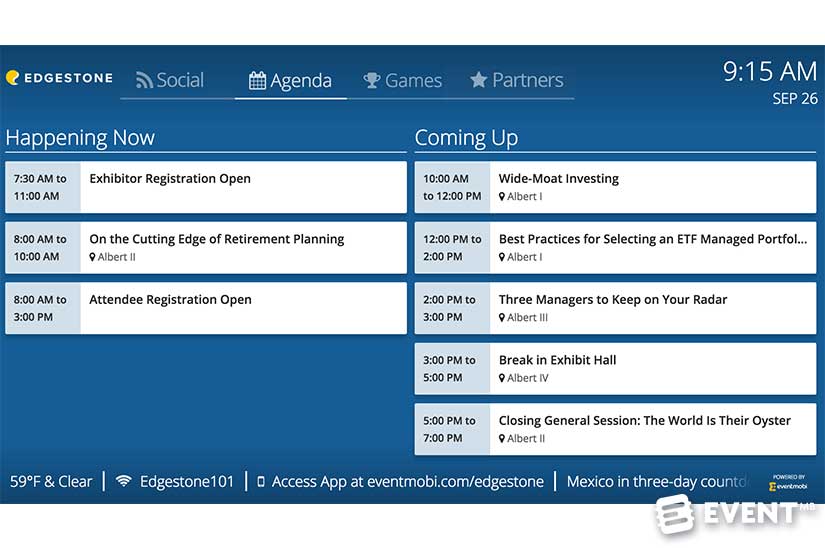

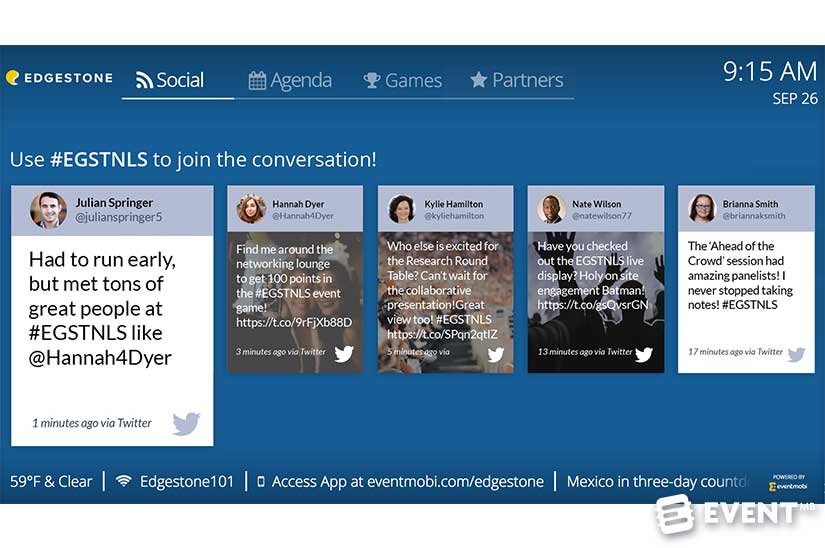

5. Increasing Attendee Engagement During Presentations and Sessions
With so much going on during an event, it can sometimes be difficult for speakers to maintain the attention of attendees. Event technology that enables polls and surveys during sessions encourages attendees to act as participants instead of bystanders. The more opportunities we provide for attendees to interact, the more value they receive.
Using an event app for polls and surveys during sessions also allows shy or hesitant attendees to ask a question. Speakers can also consider switching things up with a Q&A session mid-way through their talk. By placing their questions throughout the presentation, it acts as a fantastic way to wake everyone up. It also invites participation and lets the speaker know which topics are most engaging. Read how Virgin Holidays took advantage of live polls to amp up employee engagement at their events.
Here’s an example of what a live poll could look like on an event app:
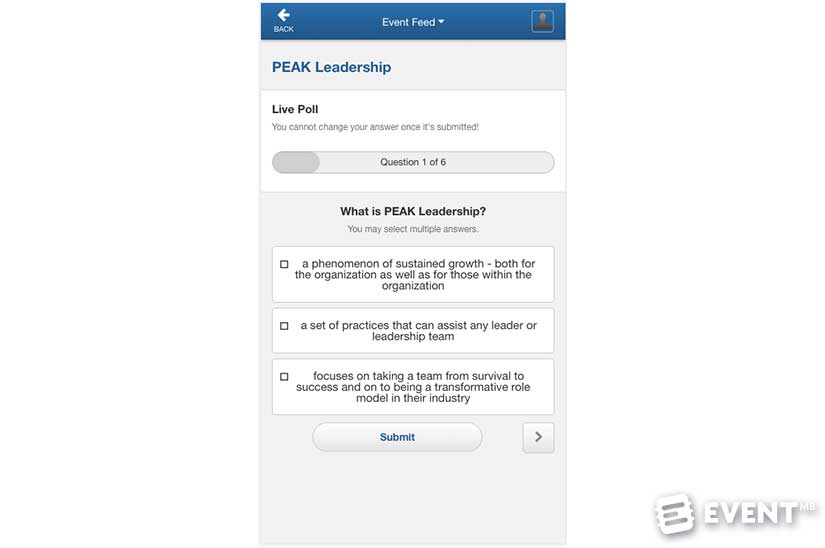

In Conclusion
Today’s event attendee demands and expects a seamless experience at all points throughout their attendee journey. This includes making it easy to register and check-in, allowing for more time to connect and communicate with other attendees, and engaging in fun activities during the event. The event industry is constantly evolving and new technologies that enable us to wow our attendees are introduced every day.
But before we look for trendy ideas, we need to make sure our attendee is the focal point. We need to take a walk in their shoes to ensure we design the best experience possible. Event technology is crucial for the digital transformation of our events, but just because we use technology doesn’t mean that the attendee is going to benefit in the end. We need to always remember that any technology we incorporate into our event design experience needs to address attendees’ needs for a personalized experience. This includes seamless logistics, relevant education, and facilitated networking. Because with great technological power comes great responsibility.

